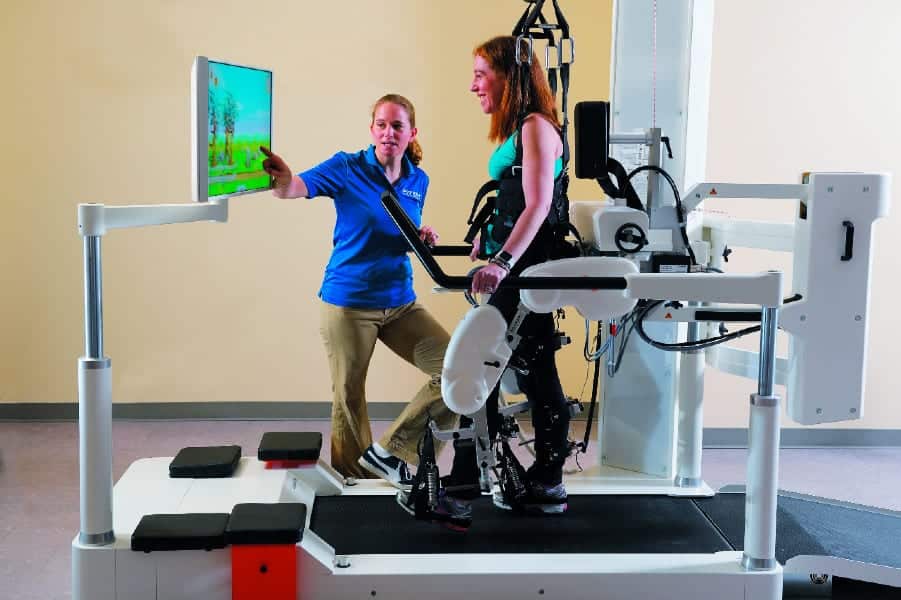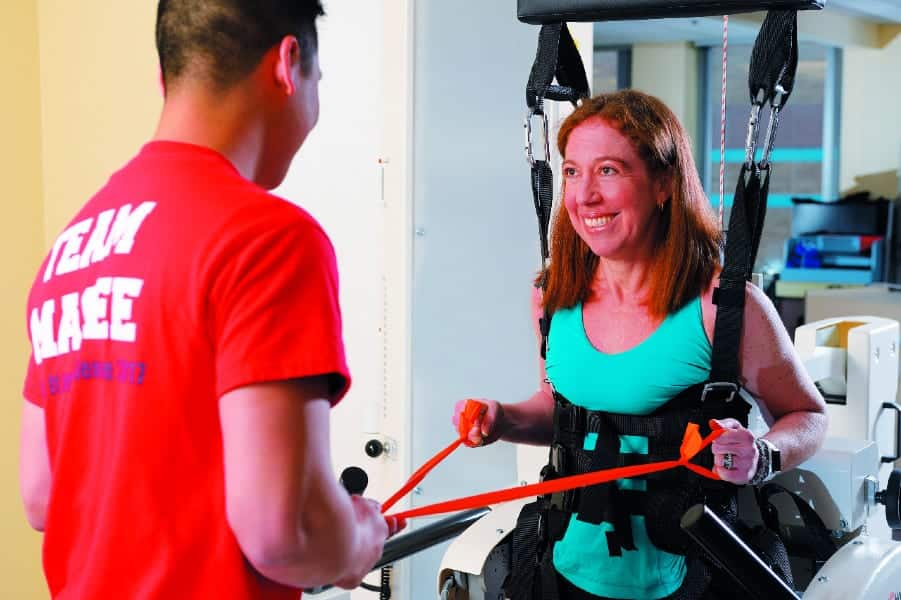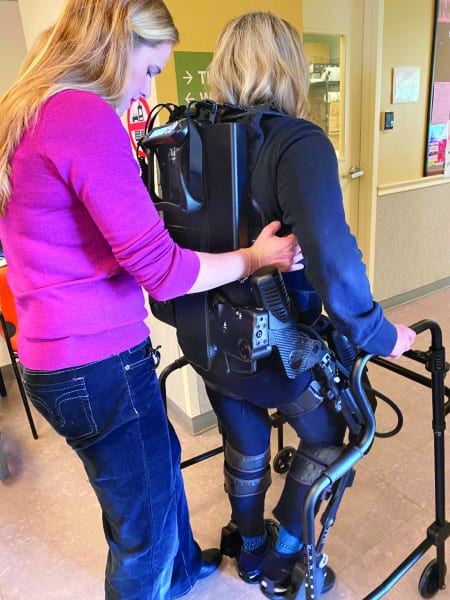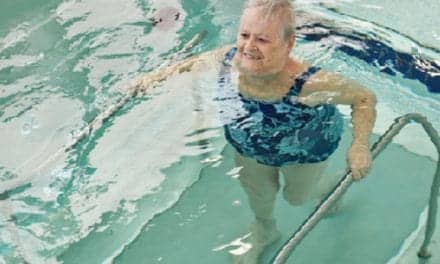photo caption: Elizabeth Watson, PT, DPT, NCS, works with a client on gait training using a robot-assisted over-treadmill dynamic body weight support system.
by Elizabeth Watson, PT, DPT, NCS
Recovery following a neurological injury is a long, slow process and does not follow a set time frame. Recovery is about more than just walking; it is about regaining function and improving overall quality of life.
This article explores a specialized program at Magee Rehabilitation Hospital-Jefferson Health in Philadelphia called Gaining Ground. The goal of Gaining Ground is to extend Magee’s mission beyond traditional physical and cognitive therapy services and reduce the barriers to continued exercise and wellness. This article also highlights the different technologies used during this program and the impact on the quality of life of the participants.
Increased evidence supports the benefits of exercise and physical activity on the physiologic and psychosocial function of individuals following neurological injuries.1 In addition, physical inactivity following a neurological injury leads to increased vulnerability to secondary health complications, including cardiovascular disease and loss of bone density and muscle mass.1 Evidence-based physical activity guidelines have been established for the general population and those with disabilities. These guidelines highlight the importance of moderate-intensity aerobic exercise and strength training for individuals with spinal cord injuries and stroke survivors.2,3
Making Progress Accessible
Barriers to continued exercise following a neurological injury include lack of accessible fitness facilities, absence of personal assistants knowledgeable about exercise programs appropriate for those with neurological injuries, absence of specialized equipment, and fear of injury. Gaining Ground was developed to reduce these barriers.
Gaining Ground is an individualized exercise program, taking into account the goals and abilities of the client. The intensive, boot camp-style program takes place 3 days a week for 4 weeks. Clients vary in presentation from those at a power wheelchair level to ambulatory patients. Some are more recently injured, just finishing outpatient therapy and looking to be challenged further and establish a wellness program. Other clients have been injured for more than 20 years and are exploring newer technologies and treatment techniques that did not exist when they were first injured. These clients find that the program’s intense nature often encourages a continued wellness program after Gaining Ground ends.
Program Structure
Each day includes 4 hours of exercise. A one-on-one training session with an activity-based therapy specialist focuses on increasing cardiovascular endurance, muscle strength and flexibility, sitting or standing tolerance, and balance. Working with a physical therapist provides the opportunity to continue working toward goals not reached during traditional therapy, as well as a chance to trial different technologies and specialized equipment working toward more neurological recovery. Once a client’s program is established, he or she is set up on specialized equipment such as a locomotor device or FES cycle for an hour of activity-based exercise.
A daily group exercise class helps increase strength, improve cardiovascular endurance, and enhance overall well-being. Exercises emphasize the muscle groups of the upper extremity and core necessary to complete daily functional activities. Group sessions include a circuit using the multi-station wheelchair-accessible weight machine, a wheelchair-accessible upper extremity exerciser, a conventional weight machine, a free weight and therapy band circuit training program, and getting onto the floor to work on whole body exercises. This allows clients the opportunity to practice getting on and off the floor in a safe environment and reduce the negative association of being on the floor related to falls. The group environment fosters interaction with others working toward a common goal.
Cardiorespiratory and strength training presented in a group setting with peers provides not just physical but also emotional improvements.1,4 Depression scores and bodily pain scores decreased after participation in a group exercise program for individuals with spinal cord injuries. Past participants of Gaining Ground have commented on the motivating environment of the group sessions.
Equipment utilized during the program may include functional electrical stimulation systems, gait training devices such as the robot-assisted over-treadmill dynamic body weight support system, mobile robotic over-ground body weight support system, lower extremity robotic exoskeletons, vibration therapy plate, computerized balance system, wheelchair-accessible upper extremity exerciser, multi-station wheelchair accessible weight machine, resistance circuit trainer, rowing ergometer, recumbent trainer, and upper body ergometer. A few of the more advanced technologies are detailed below.


Body Weight Support Training
The robot-assisted over-treadmill dynamic body weight support system utilizes robotic-assisted gait training. A harness suspends the patient over a treadmill while the legs are guided through the walking pattern using a robotic orthosis. Speed, the amount of load through the legs, and the amount of guidance provided by the robotic orthosis, are all variables that can be adjusted to appropriately challenge the client. The robot-assisted over-treadmill body weight support system enables effective and intensive training promoting neuroplasticity and recovery potential.
This system can be used with various augmented performance feedback games. The level of difficulty can be chosen based on the client’s ability and therapy focus. Studies have shown that when using augmented performance feedback, muscle activation and cardiovascular exertion can be considerably increased.5 Most clients in the Gaining Ground Program utilize this device two to three times a week.
The mobile robotic over-ground body weight support system allows a therapist to work on overground balance and gait training, bridging the gap between treadmill-based activities and free walking. The system can provide body-weight support equally or asymmetrically depending on a client’s impairments. Therapists can steer this device or choose the mode that allows a patient to work on self-directed gait. Therapists can challenge the patient with various balance and functional activities by using a balance board, steps, or varied terrain within the width of the device’s frame.
Exoskeleton Training
Another type of equipment used for upright positioning and gait training are robotic exoskeletons designed for the lower limbs. These wearable bionic suits help patients with lower extremity weakness or paralysis to stand and walk overground using a reciprocal pattern with full weight bearing using a walker, crutches, or cane. Sensors in the device trigger a step once the patient shifts weight in the appropriate manner. Motors in the hip and knee joints power the movement in place of decreased leg function. During the Gaining Ground program, therapists use the exoskeletal devices in two ways. The robotic exoskeleton allows those with motor complete spinal cord injuries the opportunity to be upright and reap the benefits of dynamic weight bearing. These include maintenance of bone mass, improved balance and trunk activation, improved sleep, mental outlook, mood and motivation, improved bowel and bladder function with decreased incidence of UTIs, decreased pain, decreased incidence of pressure ulcers, reduction in fat mass, and increase in lean body mass.
These devices can also be used to retrain weight shifting and gait patterns of clients with incomplete spinal cord injuries, and post stroke or traumatic brain injury. As a client relearns the appropriate gait pattern, the amount of assistance provided by the motors is adjusted at each leg and each joint individually to challenge the client. Improved gait parameters and gait speed have been seen following gait retraining using exoskeletal devices with individuals who have incomplete paralysis.
Functional Electrical Stimulation
Functional electrical stimulation (FES) is used in various forms during the Gaining Ground program. Some clients are set up on the FES cycle or FES seated elliptical. Electrodes are placed on up to 12 muscles of the upper extremity, core, or lower extremities. The therapist can customize the stimulation settings to evoke the desired muscle contraction for each muscle group. The motor of the cycle provides the support necessary to complete the cycling motion in conjunction with the stimulation-producing muscle contractions for either upper extremity or lower extremity cycling.
Many patients with neurological injuries experience decreased mobility and physiological function. This more sedentary lifestyle caused by immobility contributes to secondary health complications and the chance of re-hospitalization. The benefits of the FES systems extend beyond reducing muscle atrophy and improving motor function. Studies have shown a positive therapeutic benefit affecting many health conditions including pneumonia, hypertension, heart disease, spasticity, bone density, pressure wounds, urinary tract infections, sepsis, diabetes, weight gain, depression, and quality of life.6
The task-specific integrated functional electrical stimulation systems are utilized by therapists in the Gaining Ground program to work on coordinated, dynamic movement patterns and functional skills with up to 12 channels of stimulation. Each activity has the correct sequenced stimulation pattern to perform the prescribed activity. Common programs worked on during the Gaining Ground program include seated postural correction, bridging, sit to stands, standing, and UE movement patterns. One client with a diagnosis of C4 AIS B tetraplegia demonstrated improved self-feeding and the ability to access the controls on his power wheelchair joystick versus switch options after using the forward reach and grasp program for two consecutive rounds of Gaining Ground.

Case Study
Nicole suffered a T2 AIS B injury on August 18, 2018, after an auto accident. In addition to several broken vertebrae, she also suffered six broken ribs, a collapsed lung, and lacerations to her head, face, and hands. Doctors performed two surgeries on her spine, and she underwent intense respiratory therapy. Nicole attended Gaining Ground about 7 months after her injury. She “loved how it pushed [her] out of her comfort zone.” Nicole recognized the individualized nature of the program and how it could be customized to fit her goals. Nicole’s program incorporated use of the exoskeleton or the task-specific integrated FES system for postural retraining and standing during her therapy hours and the robotic over-treadmill dynamic body weight support system three times a week. The training sessions with the activity-based therapy specialist demonstrated what she could achieve independently to continue to challenge herself after the program. As a personal trainer prior to injury, Nicole found this especially valuable. Nicole demonstrated significant progress in her ability to get up and down off the floor each week and realized how important a skill this is.
Magee’s Gaining Ground Program offers clients the opportunity to improve their functional independence and emotional well-being, while setting goals for future wellness initiatives. The small group setting has proven beneficial in helping individuals achieve these goals and make new friends in the process. RM
Elizabeth Watson, PT, DPT, NCS, is clinical supervisor of the Locomotor Training Clinic at Magee Rehabilitation in Philadelphia. She also serves as adjunct professor for area physical therapy programs. In 2018, Dr Watson received the SCI Spinal Interest Group Award for Excellence. Watson earned her DPT from Temple University and is ABPTS certified in Neurologic Physical Therapy. She has presented nationally and published case studies on locomotor training. For more information, contact [email protected].
References
- Crane DA, Hoffman JM, Reyes MR. Benefits of an exercise wellness program after spinal cord injury. J Spinal Cord Med. 2017;40(2):154-158.
- Martin Ginis KA, van der Scheer JW, Latimer-Cheung AE, et al. Evidence-based scientific exercise guidelines for adults with spinal cord injury: an update and a new guideline. Spinal Cord. 2018;45:308-321.
- Gordon NF, Gulanick M, Costa F, et al. Physical activity and exercise recommendations for stroke survivors: an American Heart Association scientific statement from the Council on Clinical Cardiology, Subcommittee on Exercise, Cardiac Rehabilitation, and Prevention; the Council on Cardiovascular Nursing; the Council on Nutrition, Physical Activity, and Metabolism; and the Stroke Council. Stroke. 2004;35(5):1230-1240.
- Saunders DH, Greig CA, Mead GE. Physical activity and exercise after stroke, review of multiple meaningful benefits. Stroke. 2014;45: 3742–3747.
- Zimmerli L, Jacky M, LÜnenburger L, Reiner R, Bolliger M. Increasing patient engagement during virtual reality-based motor rehabilitation. Arch Phys Med Rehabil. 2013;94(9):1737-1746.
- Dolbow DR, Gorgey AS, Ketchum JM, Gater DR. Home-based functional electrical stimulation cycling enhances quality of life in individuals with spinal cord injury. Top Spinal Cord Inj Rehabil. 2013 Fall;19(4):324-329.





